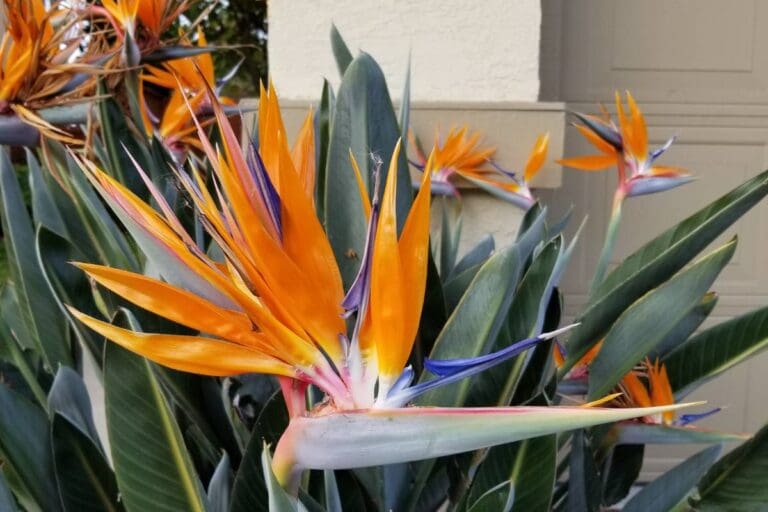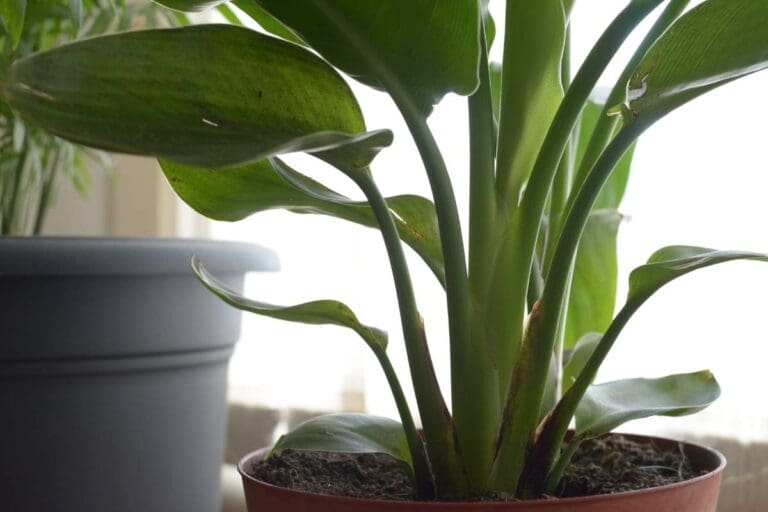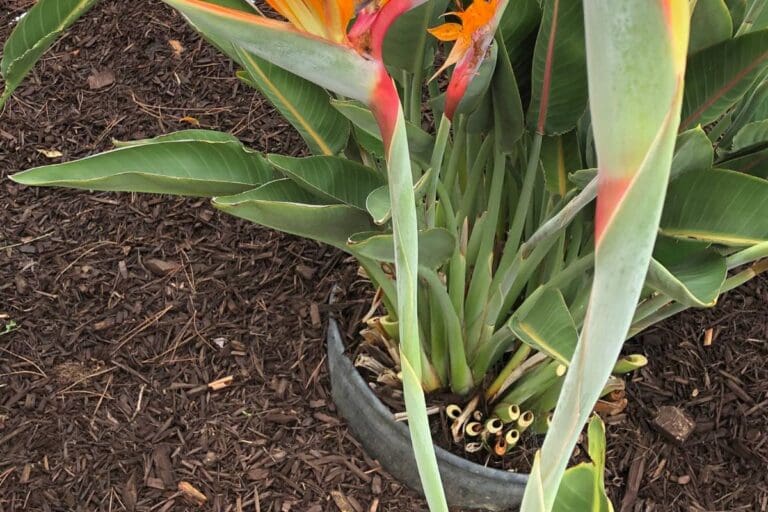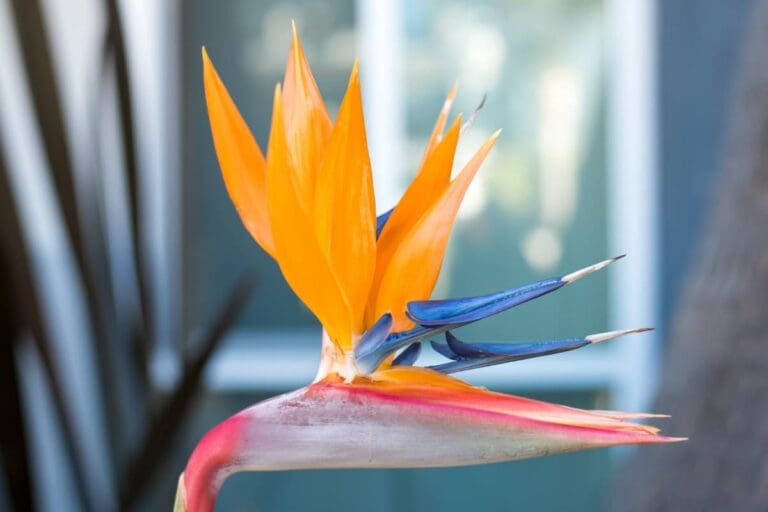Why Is My Bird of Paradise Not Growing? (8 Causes+Fix)
Bird of paradise is a stunning tropical plant that can grow large in ideal conditions. But is your bird of paradise not growing? Don’t worry, as I am here to help.
Lack of light, nutrient deficiency, and inadequate watering are the primary cause of stunted growth in birds of paradise plants. To ensure new and healthy growth, ensure the plant gets enough sun, water the plant to keep the soil moist and fertilize the plant once a month in the growing season.
There can be other reasons why your Strelitzia might not grow. In this article, I’ll help you understand the possible reasons and how you can deal with them.

Please note: Simplify Plants is reader-supported. Some links in the post are affiliate links and I get a commission from purchases made through links in the post.
Common Reasons Why Bird of Paradise Plants Don’t Grow
There can be multiple reasons why a bird of paradise might not be growing!
My bird of paradise had stopped growing when I went on a vacation.
Although I had instructed my cousin to water the plant, I found it was underwatered when I returned.
However, it didn’t take me long to rescue it.
And soon, it was growing again!
But, before I discovered it was underwatered, I researched everywhere because my bird of paradise had not grown!
It was the same size I had seen before I went on a long vacation.
So, I know there can be many reasons why a bird of paradise might not be growing.
Let’s check them out, shall we?
1. Overwatering
Overwatering is a very common issue that is prevalent in the plant community.
Although beginners are more prone to this mistake, expert plant owners occasionally overwater their plants.
Bird of paradise doesn’t react well to overwatering because it prefers well-drained soil that can get rid of the excess water.
So, if you have been overwatering it, it might be sitting in the water for too long.
When this happens, the excess water blocks airflow inside the soil, which suffocates the roots.
The roots fail to function, so the plant doesn’t get water or nutrients and stops growing.
The plant can develop deadly root rot if this situation continues too long.
2. Underwatering
I already mentioned that my bird of paradise had stopped growing due to underwatering.
It gets underwatered when you forget to check on your plant and water it on time.
As a result, the roots fail to transport nutrients or water to the plant, making it weak and dehydrated.
3. Lack of light

Lighting is common with the bird of paradise plants because, unlike many houseplants, these plants prefer some direct sunlight.
It can grow well under indirect sunlight, but the full sun helps it thrive.
But, many houses, especially in the US, do not get enough natural light, let alone full sunlight.
If you are growing your bird of paradise indoors, it might not get enough light, so it is not growing.
4. Underfertilization
Birds of paradise plants are heavy feeders.
They grow tall with large leaves and need more nutrients than many other plants.
If you are not using a fertilizer that meets its nutrient demands or not using any fertilizer at all, the bird of paradise will slow down its growth.
In the case of indoor birds of paradise, the soil remains limited, and so do the nutrients it holds.
As the plants use up the nutrients and some get washed away with watering, the need for fertilization arises.
And when it doesn’t get that, its growth gets compromised.
5. Dormancy
Most tropical plants enter a state of dormancy when the colder months arrive.
And the bird of paradise is no different.
During dormancy, the environmental conditions don’t remain ideal for the growth of these plants.
So, instead of focusing on growth, the plant focuses on surviving and saving energy.
However, this is a natural phenomenon, and you don’t have anything to worry about if your bird of paradise is not growing because it is dormant.
6. Rootbound

If you have an indoor bird of paradise, it might be rootbound, which can hamper its growth.
Rootbound is the condition when a plant has outgrown its current pot.
A slight rootbound condition is good for many plants, including the bird of paradise, as it helps them bloom.
But, when you don’t repot it for too long, it goes into a condition where the roots get tangled, the soil reduces, and the roots start coming out of the drainage holes.
That’s when the roots no longer send any nutrients or water from the soil to the plant, making it weak and stopping its growth.
7. Pests and diseases
Pests and diseases will occur if your bird of paradise is not getting the ideal growing conditions.
They can also come from a nearby pest-infested plant.
Some common pests that can attack your bird of paradise are aphids, mealybugs, scales, spider mites, etc.
All these pests feed on the sap of the plant, which carries all the nutrients that the plant needs.
When the pests feed on the nutrients that the plant needs, the plant becomes devoid of them and, as a result, stops growing.
On the other hand, diseases like leaf spots and root rot can affect the bird of paradise due to unfavorable conditions like overwatering.
These are so deadly that they can kill your Strelitzia.
But, if you can catch them on time, you can save your plant.
8. Poor water quality
Poor-quality water is an overlooked issue that can stop your bird of paradise from growing.
When you use regular tap water to water your bird of paradise, the unwanted minerals affect the soil, stopping plant growth.
You might be wrong if you think using tap water is not a problem.
You might want to send the tap water for a test to confirm this.
Tips for Helping Your Bird of Paradise Grow

Now that you know all the possible causes that can stop the growth of your bird of paradise, here are some tips that can help you deal with those issues and help your bird of paradise grow again.
1. Water the bird of paradise correctly
Both overwatering and underwatering can stop the growth of your beautiful Strelitzia.
And you can stop both by following these steps:
- First, if your bird of paradise is overwatered, place it in a spot with ample sunlight. This will allow the soil to dry. Also, don’t water till the soil dries.
- If you suspect root rot, take the plant out of the pot, check the roots, prune the damaged ones, spray a fungicide on the healthy ones, and repot the plant in a new pot with fresh potting mix.
- If your bird of paradise is underwatered, give it a good soak. You can do this by filling the sink or bathtub with water and placing the plant tub in it for 20-30 minutes.
- You can also take a chopstick, make some holes in the soil, and then water the plant.
- Always check the soil before watering your bird of paradise. Use a moisture meter or do a finger test. Water the plant if the soil is almost dry.
- If you plan to go on a long vacation, use a watering globe or keep the bird of paradise in a self-watering pot.
- The bird of paradise will need more water in the growing season and less water in the dormant season.
- Also, use well-drained soil that neither holds too much water nor drains water too fast.
- And always use a pot with drainage holes so the excess water can pass out of the pot.
2. Provide enough light
Lack of light is a big reason a bird of paradise might not grow.
Here’s how you can ensure that it gets enough light:
- Keep the bird of paradise in a spot where it gets 4-6 hours of full sun or bright indirect light.
- If your Strelitzia stopped growing due to lack of light, slowly move it to a well-lit spot. Don’t move it at once. Make it gradual, so the plant doesn’t get shocked.
- If the plant is not getting enough natural light, use artificial lights.
- However, don’t forget to protect the plant from extreme sunlight during the intense summer afternoons.
3. Fertilize properly

If a plant is a heavy feeder, you must fertilize it enough to see enough growth.
Here’s how you should fertilize your bird of paradise:
- Fertilize it with an organic, balanced 10-10-10 NPK fertilizer every 2 weeks during its growing season.
- Always dilute the fertilizer before using it; otherwise, the concentration will become too heavy.
- If you are using granular fertilizer, spread it well across the soil.
- Reduce the fertilization frequency during the colder months.
- Always water the plant thoroughly after fertilizing it.
4. Do not let the plant go extremely root bound.
Although a slight rootbound condition is fine, do not let your bird of paradise go extremely rootbound.
If your bird of paradise is rootbound, you will notice these signs:
- Roots coming out of drainage holes.
- Roots showing up from the soil
- Roots grow in a circular motion inside the pot and get tangled.
- A reduced amount of soil
Here’s what you should do if your bird of paradise is root bound:
- Inspect the roots after taking the plant out of the pot.
- Untangle the tangled roots very carefully. Make sure you don’t damage them.
- You can use a knife if you cannot untangle the roots with your finger.
- Add a fresh potting mix to a new pot size bigger than the previous one.
- Repot the bird of paradise in it.
To avoid making your bird of paradise go rootbound, repot the plant once every 2-3 years whenever it shows signs of rootbound.
Avoid repotting in winter, as that is not the ideal time or ideal condition.
5. Prevent pests and diseases

You must remember that pests and diseases can never come or survive on a healthy plant.
So, the first thing to do is provide the ideal conditions for your bird of paradise.
If your bird of paradise has pests, try these:
- Handpick the pests that you can spot on the plant.
- Give the plant a good wash to remove as many pests as possible.
- Spray a Neem oil solution or an insecticidal soap all over the plant.
- If nothing works, you can use a pesticide to eliminate the pests.
In case of fungal diseases, you need to use a fungicide and remove the affected parts so the disease cannot spread to other parts of the plant.
6. Use the right water for watering your bird of paradise.
Water quality can affect the growth of your Strelitzia.
So, if you’ve been using regular tap water to water your bird of paradise, try these:
- Use distilled water or filtered water.
- Collect rainwater and use that to water your bird of paradise.
- If you only have tap water, collect it in a bucket and leave it overnight. This will allow the minerals to dissipate. And then, you can use it to water the plant.
Final thoughts
If your bird of paradise is not growing, inspect the plant thoroughly and try to understand what stops its growth. I have discussed 8 factors that can slow down the growth of this stunning species.
Once you figure out the issue, apply the solutions that I discussed. Unless it is severe and the plant was left unnoticed for too long, you can revive it and help it grow again. Once the plant has recovered, take proper care of it.
Ensure the bird of paradise gets enough light, water, fertilizer, and the right temperature and humidity. Watch for pests and take preventive measures to protect the plant.
How Much Growth Should You Expect from An Indoors Bird of Paradise?
A bird of paradise grows as tall as 30 feet in its natural habitat! Although it doesn’t grow as much indoors or in a different environment, it can grow 5-6 feet tall with the right care.
How do I make my Bird of Paradise grow more leaves?
Providing more light is the key to encouraging the plant to grow more leaves. Use artificial lights if your house lacks natural light.
Reference: Wikipedia.
Recommended Garden Supplies
| Product Image | Our Recommended Gardening Supplies | Check Offers! |
|---|---|---|
Top Top
Top
Top
Top
Top
Top
Top
Top | rePotme Houseplant and Tropical Classic Potting Soil Mix | Check Offer On Amazon |
 Top
Top
Top
Top
Top
Top
Top
Top | Espoma Organic Indoor Plant Food | Check Offer On Amazon |
 Top
Top
Top
Top
Top
Top
Top
Top | GooingTop LED Grow Light 6000K Full Spectrum Clip Plant Growing Lamp | Check Offer On Amazon |
 Top
Top
Top
Top
Top
Top
Top
Top | Soil Moisture Meter | Check Offer On Amazon |
 Top
Top
Top
Top
Top
Top
Top
Top | Govee Hygrometer Thermometer, Bluetooth Enabled! | Check Offer On Amazon |
 Top
Top | LEVOIT Humidifiers for Large Room(Best For Plants) | Check Offer On Amazon |
 Top
Top
Top
Top
Top
Top
Top
Top | Upgraded DIY Automatic Drip Irrigation Kit, 15 Potted Houseplants Support | Check Offer On Amazon |
 Top
Top
Top
Top
Top
Top
Top
Top | Stainless Steel Heavy Duty Gardening Tool Set | Check Offer On Amazon |
 Top
Top
Top
Top
Top
Top
Top
Top | Bonide Insecticidal Soap | Check Offer On Amazon |
 Top
Top
Top
Top
Top
Top
Top
Top | Bonide 32 oz Spray Neem Oil for Organic Gardening | Check Offer On Amazon |
 Top
Top
Top
Top
Top
Top
Top
Top | Garden Safe Fungicide | Check Offer On Amazon |





